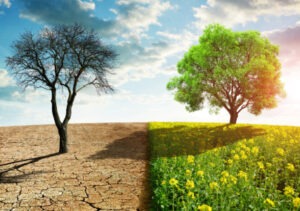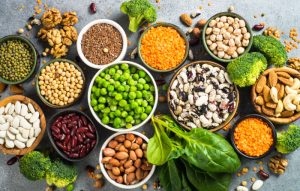The destruction goes way beyond methane emissions.
In 2018 an article was published in “Nature” which was based on the largest meta-analysis of food systems to date. The study showed that our current food system accounts for 26% of the overall carbon footprint although numbers have a wide range spanning from 18% (Steinfeld, H., etc., 2006. Livestock’s long shadow) to 51 % (Goodland, R., and J. Anhang. 2009. Livestock and climate change) depending on how direct and indirect GHG sources are calculated. In the study it was also made clear that animal agriculture contributes a whooping 58% of food’s different emissions, but only represent 38% of protein consumption and 17% of our calorie consumption globally (Poore & Nemecek, 2018).
The heavy industrialization and growing consumption of animal products has led to our food system becoming an energy sink rather than a source. Basically, we are expending more energy producing food compared to the energy we get out as a result. In fact, the industrial food system is so energy-demanding that someone eating a meal in the U.S. is ingesting only one kilocalorie of food for every 10 kilocalories spent getting that food to their plate (Bradford, 2019, The Future is Rural) .
Producing beef is especially wasteful as livestock need lots of feed for tissue building which is what humans end up eating. It is estimated that 38% of the calories produced by the world’s crops are being used for animal feed, and only 12% of those “feed calories” ultimately converts to food for humans. Thus, there is a significant loss of energy when we introduce this extra “step” due to the many resources that goes into producing the animal product.
We have covered elsewhere the role of methane and why this turbocharges the heating of our planet. But even if we were to ignore the destructive effects of methane, animal agriculture would still contribute disproportionally to the emission of greenhouse gases with beef placing at the very top.

https://ourworldindata.org/carbon-footprint-food-methane
One of the major reasons is due land use changes which happens because of the need to grow feed and the pasture management needed for grazing cows. At this point we are using almost half of the world’s habitable land for agriculture and of that, more than three-quarters is used for livestock. Keeping in mind that meat and dairy only make up 38% of the world’s protein and 17% of calories, it is not hard to see why this particular part of agriculture is so taxing on the Planet.
Unfortunately, it doesn’t stop there as animal agriculture also has a broader ecological impact. When we talk about land use change this is often at the cost of deforestation and habitat loss. Large natural areas with complex ecosystems that store tons of carbon and is home to a diverse web of life, gets cleared to create land for grazing livestock and grow feed. One example of just how grave the consequences is of this practice, is the fact that certain regions of the Amazon Rainforest, is now emitting more CO2 than it absorbs.
Another cause for concern is the manure from livestock and the fertilizer used for feed production which produces the highly potent nitrous oxide (N2O) gas. As a reference, one pound of the N2O warms the atmosphere 300 times more than a pound of carbon does over a 100-year period. According to a recent study which appeared in “Nature”, human caused N2O emissions have increased 30 percent over the past four decades and is speeding past the highest emission levels scientists have projected in climate models. Stanford Scientist, Rob Jackson, explains what is going on:
In addition the both manure and the excess fertilizer (N2O) used for growing crops, lead to water pollution and can cause what is known as eutrophication which is the process in which a water body becomes overly enriched with nutrients, leading to excessive growth of algae and plankton which again is what leads to dead zones in aquatic ecosystems (National Ocean Services). And speaking of water, livestock production needs a significant higher amount compared to growing plants as both the animals themselves need to hydrate as well as the crops grown to feed them. The average water footprint per calorie for beef is 20 times that of grain! (Heinrich Böll Foundation)
Lastly, when not managed properly, grazing livestock can lead to soil erosion which can have grave consequences such as desertification and cause loss of important native plant species and other ecological damage. Fortunately, there is a growing awareness of more regenerative methods which, when done properly, can end up working as part of the local ecosystems resulting in carbon storage rather than emissions. These practices are still rare and as an example, of the 900 million arable acres in the U.S., only about 1.5% is being farmed regeneratively (Reuters). That said, regenerative agriculture is an emerging field that is worth following as more practices are shared and scientific studies done.

As an example of this emerging field, a Danish report from February 2024 co-authored by “The Food Nation” (a non-profit public-private partnership) along with “Boston Consulting Group” and “The Danish Society for Nature Conservation”, looks at the economic and environmental benefits of transitioning Denmark’s agricultural sector into Regenerative Agriculture. In the report, regenerative agriculture is broadly defined as:
“…a collection of flexible, sustainable farming practices intended to align with natural systems, the report outlines the key goal of Regenerative Agriculture to be the restoration of soil health and surrounding ecosystems by focusing on three core principles:
- No-till farming (including direct seeding): Using no-till practices helps preserve soil structure and enhances the conservation of organic matter.
- Permanent coverage of the soil with plants: Ensuring continuous vegetation cover protects the soil from erosion, improves water retention, and supports biodiversity.
- Wider crop rotation: Implementing diverse crop rotations promotes more robust ecosystems and reduces the need for synthetic fertilizers.”
The report acknowledges that the transition would be gradual as it would take several years to achieve. At the same time there is no “one size fits all” but rather it would require great flexibility in approach, as even in a geographically small country like Denmark, individual farms still may require different regenerative practices based on their unique climate and soil characteristics. That said, the report concludes that there are great environmental benefits such as a reduction of use in fossil fueled farming machinery and synthetic fertilizers, improved soil health and thus enhanced carbon sequestration, water retention and an overall healthier ecosystem. On top of these benefits, there are also economic benefits for the farmers as well as a collective benefit for the whole Agri-Food System. You can find the complete report here.
In conclusion, the damages from our current food system and in particular animal agriculture is very real and should cause us to pause and consider how we choose to fuel ourselves and loved ones. A recent study published in July 2023 in “Nature” shows just how much of an impact our diets can have if we were to dial down our intake of meat and instead dial up on the greens and grains.
Just in terms of greenhouse gas emissions, a vegan diet accounts for a quarter of that of meat eaters (people that would eat 100g or more meat per day). In addition, we would only need one quarter of the land compared to what we use today (which as you may recall was HALF the arable land of the planet!). We would use less than half the water and our impact on eutrophication (the process which, among other things, is responsible for dead zones in oceans) would be roughly one quarter of what it is now. With this change we would also reduce our impact on biodiversity to one third of what it is now and, in the process, preserve the beautiful diversity of life we have on this planet.(Nature)
Did we mention there are also numerous health benefits which we covered here? If you are just a little bit inspired, check out our “10 tips to start a plant-based diet” here.



